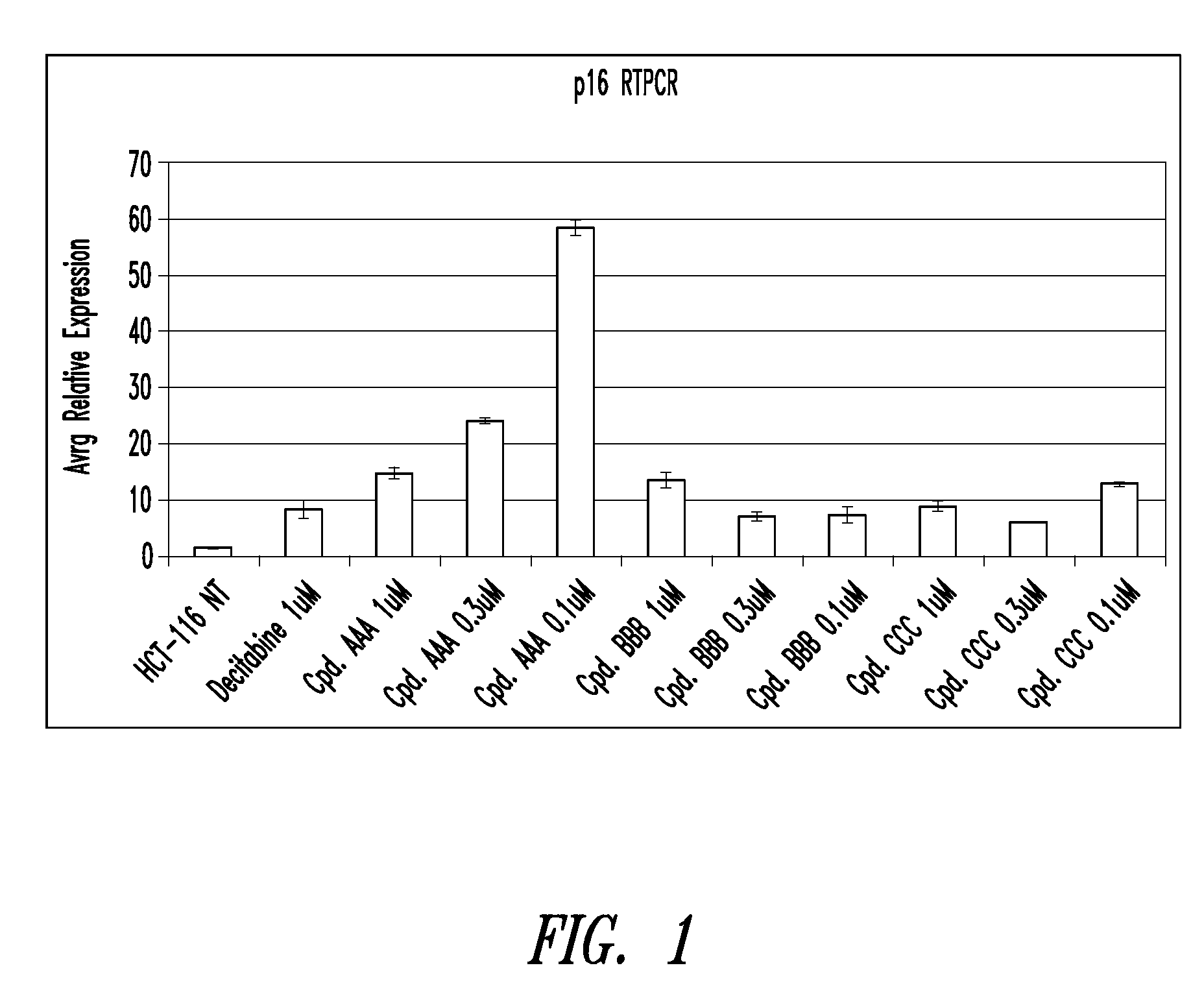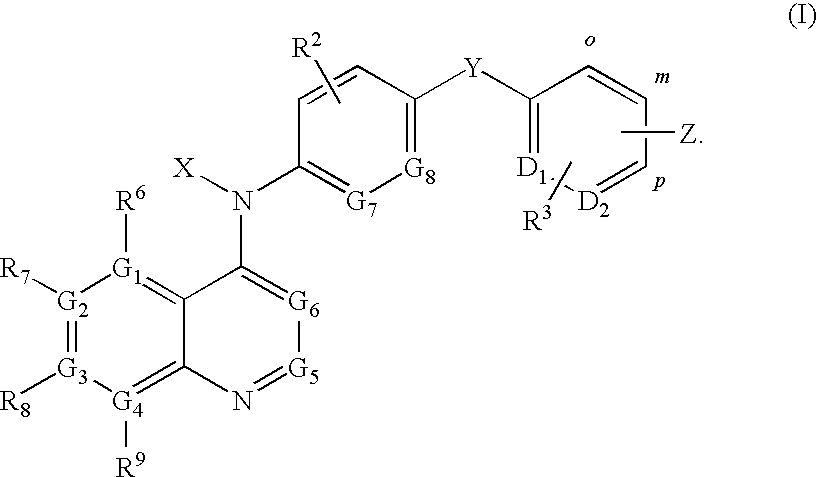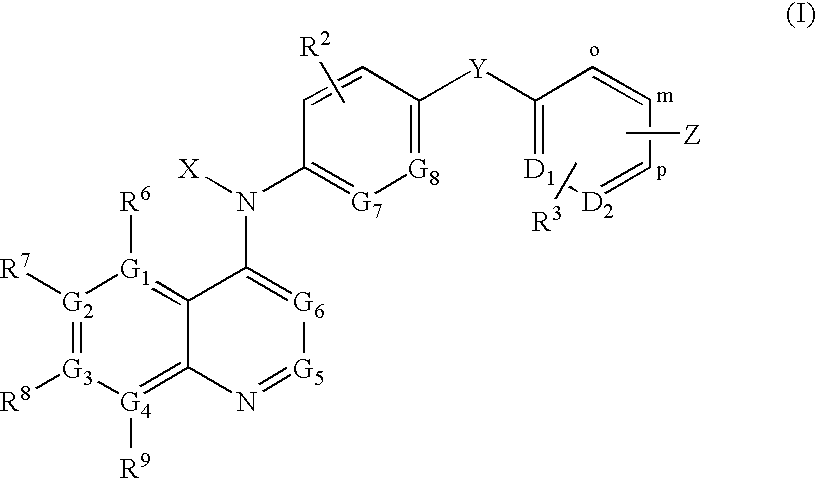Quinoline derivatives for modulating DNA methylation
a technology of dna methylation and quinoline derivatives, which is applied in the field of quinoline derivatives, can solve problems such as interfering with the normal process of dna methylation, and achieve the effects of reducing function/activity, reducing such function/activity, and reducing dna methylase activity
- Summary
- Abstract
- Description
- Claims
- Application Information
AI Technical Summary
Benefits of technology
Problems solved by technology
Method used
Image
Examples
examples
[0202]The following examples are representative of the invention, and provide detailed methods for preparing the compounds of the invention. In these examples, elemental analyses were carried out in the Microchemical Laboratory, University of Otago, Dunedin, NZ. Melting points were determined on an Electrothermal 2300 Melting Point Apparatus. NMR spectra were obtained on a Bruker Avance-400 spectrometer at 400 MHz for 1H and 100 MHz for 13 C spectra, referenced to Me4Si. Mass spectra were determined on a VG-70SE mass spectrometer using an ionizing potential of 70 eV at a nominal resolution of 1000. High-resolution spectra were obtained at nominal resolutions of 3000, 5000, or 10000 as appropriate. All spectra were obtained as electron impact (EI) using PFK as the reference unless otherwise stated. Column chromatography was carried out on silica gel, (Merck 230-400 mesh) unless otherwise stated.
example a
Preparation of 1-Methyl-4-(3-{[4-(4-Quniolinylamino)Benzoyl]Amino}Anilino)Pyridinium Chloride (Cpd. A)
[0203]
[0204]N-(3-Nitrophenyl)-4-pyridinamine (A3). A suspension of p-toluenesulfonic acid monohydrate (17.4 g, 0.126 mol) in benzene was azeotroped for 10 h. Phenol (50 g) was added and the mixture was azeotroped for 2 h, then 4-pyridylpyridinium chloride (26.6 g, 0.138 mmol) and 3-nitroaniline (17.4 g, 0.126 mmol) was added and the mixture was azeotroped for 3 h. Benzene was removed under reduced pressure and the resulting black residue was heated to 180° C. for 1 h. The reaction mixture was cooled to 20° C., and 4N NaOH (150 mL) was added. The mixture was stirred for 30 min, and then diluted with water (2 L). This mixture was stirred in CH2Cl2 (1 L) and the resulting precipitate was filtered and washed with more CH2Cl2. The solid was recrystallized from MeOH / H2O to give A3 (11.9 g), as a yellow solid: mp (MeOH / H2O) 182-184° C. Further material was recovered from CH2Cl2 washes, by ...
example b
Preparation of 1-Methyl-4-(4-(4-(Quinolin-4-Ylamino)Benzamido)Phenylamino)Pyridinium Chloride Hydrochloride (Cpd. B)
[0210]
[0211]N-4-Nitrophenyl)-4-pyridinamine (B3). 4-Toluenesulfonic acid (53.80 g, 0.28 mol) was dissolved in benzene (200 mL), and the resulting solution refluxed under Dean-Stark conditions for approximately 96 h, until evolution of H2O ceased. To this solution was added phenol (112.25 g, 1.19 mol), and the resulting mixture refluxed under Dean-Stark conditions for approximately 1 h, until evolution of H2O ceased. After this time, 1-(4-pyridyl)-pyridinium chloride (59.95 g, 0.31 mol) (A2) and 4-nitroaniline (B1) were added, and the resulting mixture was refluxed under Dean-Stark conditions for approximately 2 h, until evolution of H2O ceased. After this time, benzene was removed under reduced pressure, and the resulting black residue heated to 180° C. for 2 h. The residue was then cooled to room temperature, and basified thoroughly by addition of 4 N aqueous NaOH. Th...
PUM
| Property | Measurement | Unit |
|---|---|---|
| temperature | aaaaa | aaaaa |
| temperature | aaaaa | aaaaa |
| volume | aaaaa | aaaaa |
Abstract
Description
Claims
Application Information
 Login to View More
Login to View More - R&D
- Intellectual Property
- Life Sciences
- Materials
- Tech Scout
- Unparalleled Data Quality
- Higher Quality Content
- 60% Fewer Hallucinations
Browse by: Latest US Patents, China's latest patents, Technical Efficacy Thesaurus, Application Domain, Technology Topic, Popular Technical Reports.
© 2025 PatSnap. All rights reserved.Legal|Privacy policy|Modern Slavery Act Transparency Statement|Sitemap|About US| Contact US: help@patsnap.com



